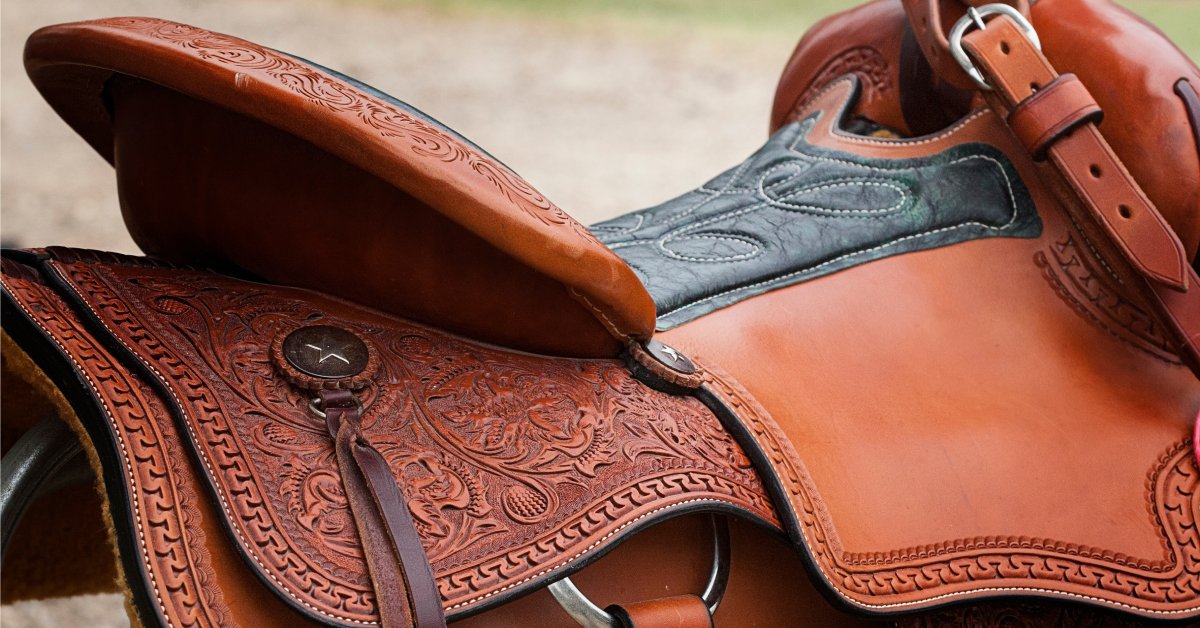Purchasing a shiny, new Western saddle is incredibly exciting. However, fresh-out-of-the-box saddles can feel stiff and uncomfortable, causing you to worry that you made the wrong choice.
You’ll need to break in your saddle properly to ensure you and your horse can ride safely and comfortably. Western horse riders know that a well-fitted, broken-in saddle is essential for long hours on the trail or in the arena. The following guide shows you how to break in a new Western saddle for a comfortable ride.
Why Breaking in Your Saddle Matters
A new Western saddle often consists of high-quality leather, which is naturally rigid when it’s first manufactured. Leather needs time and care to soften and mold to fit the horse and the rider perfectly. Without proper breaking in, a stiff saddle can cause discomfort and uneven pressure and create sore spots on your horse.
Breaking in your saddle is about safety, too. A properly broken-in saddle allows you to move fluidly with your horse, which is especially important for activities such as barrel racing, trail riding, or team roping.
A stiff saddle can restrict movement and cause unnecessary tension for you and your horse. Investing time in the breaking-in process will pay off in years of enjoyable and safe rides.
Start With a Proper Fit

Before you can break in your saddle, ensure it fits correctly. Even the most expensive saddle won’t break in properly if it doesn’t suit your horse’s conformation. A poor fit can lead to uneven wear, pressure points, and an unhappy horse.
To check the fit, place the saddle on your horse’s back without any padding. Look for even contact along the saddle bars and ensure there’s enough clearance for the withers.
The saddle should sit level and not rock back and forth. If you’re unsure, consult a professional saddle fitter or your local tack store. A well-fitting saddle makes the breaking-in process much smoother and ensures your horse’s comfort from the start.
Use Leather Conditioner Generously
Leather conditioner is your best friend when breaking in a new Western saddle. Fresh leather is stiff and needs moisture to become pliable. Applying a high-quality leather conditioner softens the material and helps it mold to your horse’s back and your riding style.
Start by cleaning the saddle with a damp cloth to remove any dust or residue. Then, apply the conditioner using a clean sponge or cloth, working it into the leather in circular motions.
Pay special attention to the fenders, stirrup leathers, and seat, as these are the parts that require the most flexibility. Let the conditioner absorb fully before riding. Regular conditioning during the breaking-in process will keep the leather soft and help it conform to your needs.
Ride Often, But Keep It Short
Frequent, short rides are the key to breaking-in a new saddle. Every time you ride, the leather naturally flexes and molds to your horse’s shape and your riding posture. Start with rides of 15-20 minutes to avoid putting too much pressure on the leather before it’s fully broken in.
Focus on light, varied activities during these initial rides. Walking, trotting, and small circles help the saddle adapt to your horse’s movements.
Avoid high-intensity tasks such as galloping or steep climbs during the early stages. Over time, gradually increase the duration and intensity of your rides as the saddle becomes more comfortable for you and your horse.
Adjust and Check Regularly
As you break in your saddle, keep an eye on its fit and condition. Leather stretches and molds over time, which can slightly alter the saddle’s fit.
Regularly inspect the saddle for uneven wear or signs of pressure points. Check the girth and stirrup adjustments to keep them comfortable as the leather softens.
Additionally, monitor your horse’s back for any signs of discomfort, such as swelling or sore spots. If you notice any issues, adjust the saddle’s position or padding. Staying proactive during the breaking-in process ensures a smoother experience and prevents long-term problems.
Use Saddle Pads Strategically

Saddle pads play a significant role in the breaking-in process. A good pad provides cushioning and helps distribute pressure evenly across your horse’s back.
During the initial rides, choose a thicker pad to compensate for the new saddle’s stiffness. As the saddle breaks in, you can switch to a thinner pad or one with specific features, such as gel inserts or contoured designs, to suit your riding needs.
Clean your saddle pad regularly to prevent dirt and sweat buildup, which can cause irritation. Combining a quality saddle pad with a properly broken-in saddle ensures maximum comfort for your horse.
Don’t Forget About the Stirrups
Stiff stirrup leathers are a common issue with new Western saddles. Breaking in the fenders and stirrups is essential for achieving a comfortable ride.
Start by bending the fenders back and forth to loosen the leather. Some riders like to place a broomstick through the stirrups and twist it to shape them overnight.
Keep an eye on how the stirrups feel when riding. If they’re still stiff, continue to flex them manually or use leather conditioner to soften them.
Comfortable stirrups make a huge difference when spending long hours in the saddle. You’ll feel your confidence start to grow once your equipment no longer causes you or your horse pain.
Be Patient and Consistent
Breaking in a new Western saddle takes time, but the effort is well worth it. Consistency is key. Regular rides, proper care, and attention to detail will help the saddle conform to your horse and your riding style.
Rushing the process can lead to discomfort for all parties involved. By taking a patient approach, you’ll enjoy a saddle that feels like an extension of your own body.
Over time, you’ll notice how the leather softens and molds perfectly to fit, providing the ideal combination of support and flexibility. Further, buying a high-quality leather saddle from a reputable supplier like Coolhorse can make the break in period easier and less time-consuming.
Coolhorse: Your Go-To Shop for New Western Saddles
Learning how to break in a new Western saddle for a comfortable ride is an essential skill for any serious rider. You can transform a stiff new saddle into a reliable companion by focusing on proper fit, regular conditioning, and consistent use.
Western horse saddles are an investment, and taking the time to break them in correctly allows you and your horse to enjoy every ride to the fullest. Visit Coolhorse today to find the perfect saddle that enhances your skills and meets the demands of rodeo, ranch, or competitive riding.

